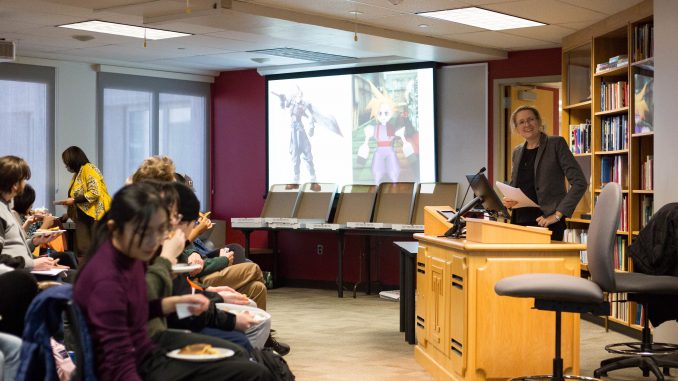
Rachael Hutchinson, a professor of Japanese Studies at the University of Delaware, spoke to Temple students about the cultural implications of Japanese video games at a lecture in Anderson Hall on Wednesday afternoon. The talk was hosted by the Department of Asian and Middle Eastern Languages and Studies.
Hutchinson began her talk by discussing different classic Japanese media. Hutchinson showed attendees pictures of Rashomon, a 1950 film, and Kokoro, a 1914 novel written by Natsume Soseki. When Kokoro was published, it was serialized in the Asahi Shimbun newspaper, Hutchinson said.
“It was very accessible to everybody,” said Hutchinson, who published her book “Japanese Culture Through Videogames” in 2019.
Though the book is celebrated today as “high-art”, it was seen as “low-class” at the time of its release, Hutchinson said.
The same is true today for video games, Hutchinson said.
Video games reflect important aspects of Japanese culture just like Rashomon and Kokoro did, Hutchinson said. As part of her research for her book, she analyzed elements of Japanese culture through character design, background environment, aesthetic style, thematic content, game dynamics and goals of video games, she said.
Hutchinson presented examples of how Japanese culture can be analyzed through these angles with different video games.
Hutchinson started with a discussion of character design.
“Many Japanese games, particularly role-playing games, feature characters who look like this: big hair, blue eyes, a slim yet muscular physique, big swords and interesting clothing,” Hutchinson said.
Many young men in video games have big, spiky hair. This hairstyle, fashioned on a character called Cloud Strife from the video game Final Fantasy 7, demonstrates the “character’s dynamism,” of energy and how eager young Japanese men are to be active, Hutchinson said.
“This admirable quality in a young Japanese man has been constant in character design since the Meiji period in the 1800s,” Hutchinson said, referencing a period of time in Japanese history in which many young men started getting involved in the government.
Hutchinson also talked about the conclusion that can be drawn about Japanese culture from the games’ environments. For instance, the Legend of Zelda: Breath of the Wild takes place in an outdoor, lush green setting where collecting seeds expands a player’s inventory of weapons, Hutchinson said.
“‘Paying attention to nature helps you’ is the message,” Hutchinson said.
Similar to the underlying theme of the Legend of Zelda: Breath in the Wild, Japanese culture values nature, she added.
In contrast to Legend of Zelda: Breath in the Wild, horror games like Resident Evil take place in, “closed-in rooms and dark spaces and a dark palette to create this feeling of claustrophobia,” Hutchinson said.
While giving an example of how to analyze thematic content, Hutchinson talked about how bioengineering is portrayed negatively in video games of the mid-1990s. This was around the same time that Dolly the sheep, the first cloned mammal, was created.
“Following 1996, there was a slew of laws enacted in Japan and around the world banning cloning,” Hutchinson said.
In the video game Metal Gear Solid, bioengineering is used to clone violent soldiers from the genetics of a famous soldier, said Hutchinson. Another game, Tekken, revolves around corporate bioengineering which results in Jin Kazama, the game’s main character, having a devil gene that makes him have outbursts of anger and grow horns and wings, Hutchinson said.
These games all put bioengineering in a negative light which demonstrates Japan’s attitude towards genetic engineering, Hutchinson said. Japan implemented a law banning human cloning in 2001.
Hutchinson hopes that students who attended her talk will learn about how videogames can be tools for learning about the culture, she said.
“Video games are really cultural artifacts, you know, in life and then we can use video games from different places around the world to actually learn about the culture from that place,” Hutchinson said.
The event was planned by Barbara Thornbury, chair of the Department of Asian and Middle Eastern Languages and Studies. Thornbury was happy with how the talk turned out, she said.
“Her lively and stimulating lecture offered interesting new ways of thinking about the Japanese cultural content of several globally popular video games—and how those games express Japanese perspectives on social, historical, environmental, and other critical issues,” Thornbury said.
Riku Long, a junior Public Relations major who attended the talk, was familiar with most of the games Hutchinson discussed, particularly Final Fantasy VII, he said.
“I felt that I got a fresh, new perspective on the games that I kind of played during my childhood and still play now,” Long said. “Listening to the lecture and how she talked about how it can reflect some of the stuff that was going on at the time. It kind of made me think about the themes of the game once more.”


Be the first to comment